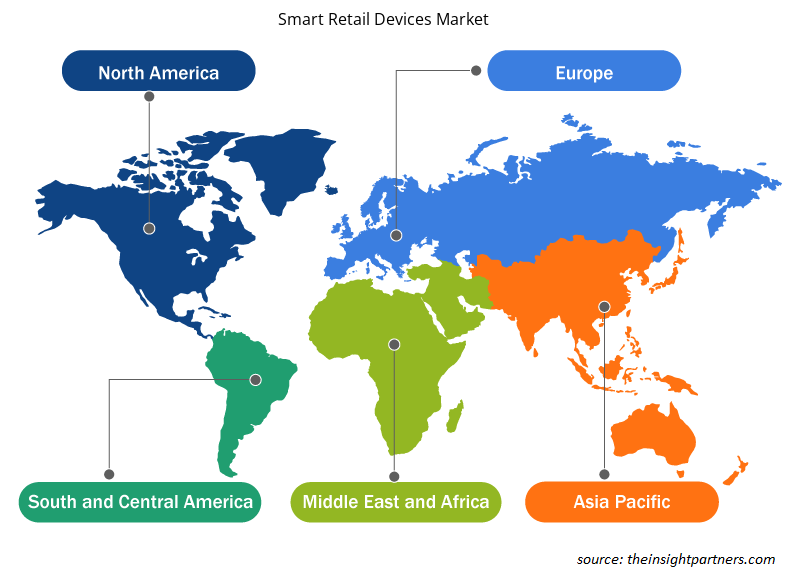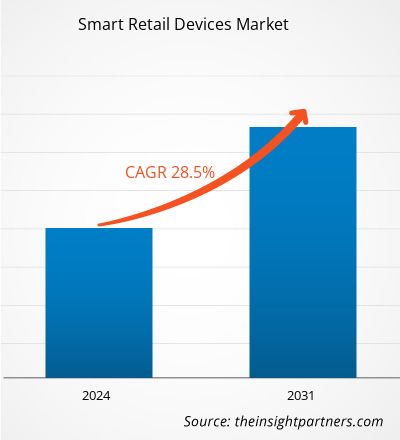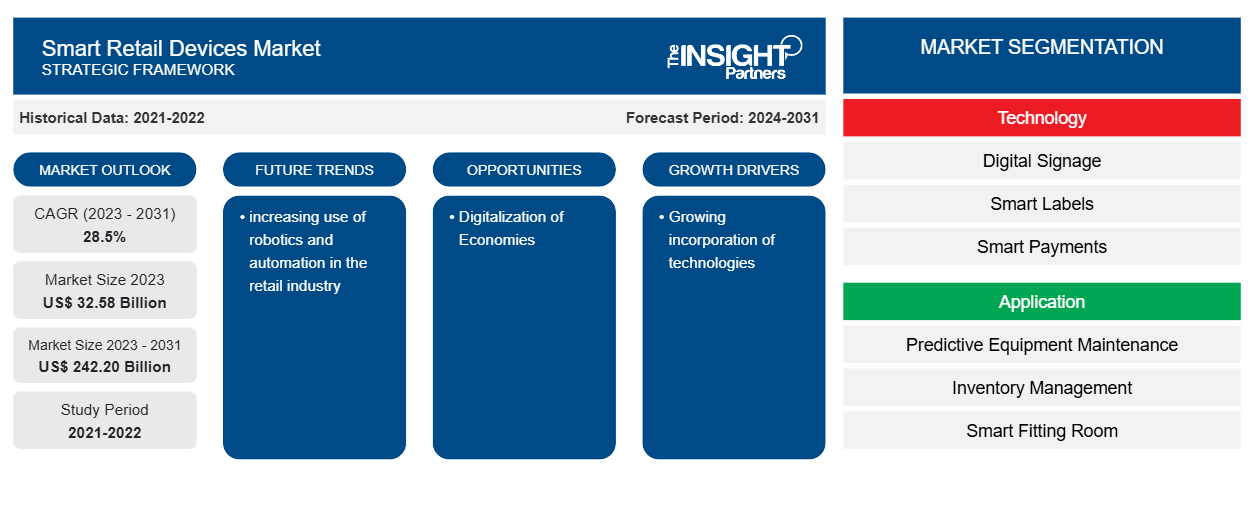من المتوقع أن ينمو حجم سوق أجهزة البيع بالتجزئة الذكية من 32.58 مليار دولار أمريكي في عام 2023 إلى 242.20 مليار دولار أمريكي بحلول عام 2031؛ ومن المتوقع أن يتوسع بمعدل نمو سنوي مركب قدره 28.5٪ من عام 2024 إلى عام 2031. ومن المرجح أن يظل الاستخدام المتزايد للروبوتات والأتمتة في صناعة البيع بالتجزئة أحد الاتجاهات الرئيسية في سوق أجهزة البيع بالتجزئة الذكية.
تحليل سوق أجهزة البيع بالتجزئة الذكية
إن الاعتماد المتزايد على تحليلات البيانات الضخمة وإنترنت الأشياء (IoT) في قطاع البيع بالتجزئة إلى جانب الارتفاع الكبير في القدرة الشرائية للمستهلكين هي العوامل المحركة الرئيسية لسوق أجهزة البيع بالتجزئة الذكية.
نظرة عامة على سوق أجهزة البيع بالتجزئة الذكية
إن البيع بالتجزئة الذكي هو استخدام التكنولوجيا والبيانات لتحسين تجارب التسوق للعملاء وعمليات الشركات. تسمح هذه التقنيات للمؤسسات بتحسين تجربة العملاء وتبسيط الإجراءات والحصول على رؤى مهمة حول سلوك المستهلك. تتيح هذه الأدوات المتصلة بالإنترنت للمستخدمين الوصول بسهولة إلى المعلومات والخدمات المخصصة، في حين تجعل القدرات المتطورة مثل التعرف على الكلام وتكامل لوحة اللمس التسوق أمرًا سهلاً، مع وجود مساعدين افتراضيين يقودون المستهلكين إلى اختيار السلع المناسبة ، وتصفح الصفقات المثيرة للاهتمام، وإجراء عمليات الشراء، وحتى التقاط التجارب ومشاركتها على وسائل التواصل الاجتماعي.
قم بتخصيص هذا التقرير ليناسب متطلباتك
ستحصل على تخصيص لأي تقرير - مجانًا - بما في ذلك أجزاء من هذا التقرير، أو تحليل على مستوى الدولة، وحزمة بيانات Excel، بالإضافة إلى الاستفادة من العروض والخصومات الرائعة للشركات الناشئة والجامعات
-
احصل على أهم اتجاهات السوق الرئيسية لهذا التقرير.ستتضمن هذه العينة المجانية تحليلاً للبيانات، بدءًا من اتجاهات السوق وحتى التقديرات والتوقعات.
محركات وفرص سوق أجهزة البيع بالتجزئة الذكية
تزايد دمج التكنولوجيا لصالح السوق
يتم استخدام دمج التقنيات مثل الذكاء الاصطناعي والواقع الافتراضي والواقع المعزز وإنترنت الأشياء بشكل متزايد في صناعة التجزئة لتحسين تجربة التسوق وتحسين إدارة المخزون وتبسيط عمليات المتجر. يعد إنترنت الأشياء مكونًا مهمًا في بيئة البيع بالتجزئة الذكية لأنه يربط الأدوات بالإنترنت ويقدم بيانات حيوية عن سلوك العملاء وعمليات المتجر وإدارة المخزون. تمكن أجهزة إنترنت الأشياء، مثل أجهزة الاستشعار والمنارات، التجار من جمع البيانات في الوقت الفعلي حول مستويات المخزون وتدفق العملاء وأصول المتجر، مما يسمح لهم باتخاذ قرارات أكثر استنارة وتحسين العمليات.
رقمنة الاقتصادات
يوفر استخدام الرقمنة العديد من الفوائد للمتاجر، بما في ذلك اكتساب مستهلكين جدد وخفض تكاليف التشغيل. بالإضافة إلى ذلك، تتمتع الرقمنة بالقدرة على تشجيع موظفي التجزئة بشكل كبير. ونتيجة لذلك، قد يشهد تجار التجزئة زيادة في إيراداتهم. والجدير بالذكر أن التسوق خارج المتاجر شهد نموًا كبيرًا في عام 2020. ومن المرجح أن تستفيد منافذ البيع بالتجزئة عبر الإنترنت بشكل كبير من التحسينات التكنولوجية، وزيادة الاتصال، وإدخال أجهزة استشعار جديدة، وتوافر حلول اتصال سلسة ، وبالتالي المساهمة بشكل كبير في نمو السوق طوال فترة التوقعات.
تقرير تحليل تجزئة سوق أجهزة البيع بالتجزئة الذكية
إن القطاعات الرئيسية التي ساهمت في اشتقاق تحليل سوق أجهزة البيع بالتجزئة الذكية هي التكنولوجيا والتطبيق.
- بناءً على التكنولوجيا، ينقسم السوق إلى لافتات رقمية، وملصقات ذكية، ومدفوعات ذكية، وعربات ذكية، وغيرها. احتل قطاع اللافتات الرقمية حصة سوقية أكبر في عام 2023.
- من حيث التطبيق، ينقسم السوق إلى صيانة المعدات التنبؤية، وإدارة المخزون، وغرفة القياس الذكية، ومراقبة حركة المشاة وغيرها. احتل قطاع إدارة المخزون حصة سوقية أكبر في عام 2023.
تحليل حصة سوق أجهزة البيع بالتجزئة الذكية حسب المنطقة الجغرافية
ينقسم النطاق الجغرافي لتقرير سوق أجهزة البيع بالتجزئة الذكية بشكل أساسي إلى خمس مناطق: أمريكا الشمالية، ومنطقة آسيا والمحيط الهادئ، وأوروبا، والشرق الأوسط وأفريقيا، وأمريكا الجنوبية/أمريكا الجنوبية والوسطى. سيطرت أمريكا الشمالية على سوق أجهزة البيع بالتجزئة الذكية في عام 2023. ومن المتوقع أن تكون هذه المنطقة هي أكبر مصدر للإيرادات في السوق خلال الإطار الزمني المتوقع بالكامل. إن الرغبة المتزايدة في المنتجات الفاخرة الراقية، إلى جانب التحولات الديناميكية في تفضيلات العملاء نحو تجارب البيع بالتجزئة الأكثر ملاءمة وكفاءة في الوقت، هي عوامل رئيسية تدفع هذا الاتجاه. علاوة على ذلك، فإن التكامل الواسع النطاق للتكنولوجيا الرقمية عبر مختلف القطاعات يعيد تشكيل الاقتصاد الأمريكي. لقد أدت عواقب الوباء إلى تسريع التحول الرقمي للشركات داخل صناعة التجزئة بشكل كبير، متجاوزة التوقعات السابقة.
رؤى إقليمية حول سوق أجهزة البيع بالتجزئة الذكية
لقد قام المحللون في Insight Partners بشرح الاتجاهات والعوامل الإقليمية المؤثرة على سوق أجهزة البيع بالتجزئة الذكية طوال فترة التوقعات بشكل شامل. يناقش هذا القسم أيضًا قطاعات سوق أجهزة البيع بالتجزئة الذكية والجغرافيا في جميع أنحاء أمريكا الشمالية وأوروبا ومنطقة آسيا والمحيط الهادئ والشرق الأوسط وأفريقيا وأمريكا الجنوبية والوسطى.

- احصل على البيانات الإقليمية المحددة لسوق أجهزة البيع بالتجزئة الذكية
نطاق تقرير سوق أجهزة البيع بالتجزئة الذكية
| سمة التقرير | تفاصيل |
|---|---|
| حجم السوق في عام 2023 | 32.58 مليار دولار أمريكي |
| حجم السوق بحلول عام 2031 | 242.20 مليار دولار أمريكي |
| معدل النمو السنوي المركب العالمي (2023 - 2031) | 28.5% |
| البيانات التاريخية | 2021-2022 |
| فترة التنبؤ | 2024-2031 |
| القطاعات المغطاة |
حسب التكنولوجيا
|
| المناطق والدول المغطاة |
أمريكا الشمالية
|
| قادة السوق وملفات تعريف الشركات الرئيسية |
|
كثافة اللاعبين في سوق أجهزة البيع بالتجزئة الذكية: فهم تأثيرها على ديناميكيات الأعمال
يشهد سوق أجهزة البيع بالتجزئة الذكية نموًا سريعًا، مدفوعًا بالطلب المتزايد من المستخدم النهائي بسبب عوامل مثل تفضيلات المستهلكين المتطورة والتقدم التكنولوجي والوعي المتزايد بفوائد المنتج. ومع ارتفاع الطلب، تعمل الشركات على توسيع عروضها والابتكار لتلبية احتياجات المستهلكين والاستفادة من الاتجاهات الناشئة، مما يؤدي إلى زيادة نمو السوق.
تشير كثافة اللاعبين في السوق إلى توزيع الشركات أو المؤسسات العاملة في سوق أو صناعة معينة. وهي تشير إلى عدد المنافسين (اللاعبين في السوق) الموجودين في مساحة سوق معينة نسبة إلى حجمها أو قيمتها السوقية الإجمالية.
الشركات الرئيسية العاملة في سوق أجهزة البيع بالتجزئة الذكية هي:
- شركة إنتل
- مجموعة سامسونج
- شركة NVIDIA
- إل جي إلكترونيكس
- شركة زيبرا تكنولوجيز
- شركة كابر
إخلاء المسؤولية : الشركات المذكورة أعلاه ليست مرتبة بأي ترتيب معين.

- احصل على نظرة عامة على أهم اللاعبين الرئيسيين في سوق أجهزة البيع بالتجزئة الذكية
أخبار سوق أجهزة البيع بالتجزئة الذكية والتطورات الأخيرة
يتم تقييم سوق أجهزة البيع بالتجزئة الذكية من خلال جمع البيانات النوعية والكمية بعد البحث الأولي والثانوي، والتي تتضمن منشورات الشركات المهمة وبيانات الجمعيات وقواعد البيانات. فيما يلي قائمة بالتطورات في السوق:
- في يونيو 2023، تعاونت إنتل وفيريكاست لتطوير وتنفيذ وتقييم شبكة وسائط رقمية متطورة قابلة للبرمجة للبيع بالتجزئة داخل المتاجر. يستفيد هذا النظام المبتكر من تكنولوجيا الاستهداف المتقدمة من فيريكاست ومنصات البرامج القوية من إنتل لتقديم إعلانات مخصصة وتفاصيل المنتج التي تتوافق مع رحلة تسوق العميل. يعد هذا التعاون عنصرًا أساسيًا في مبادرتنا الأوسع لإحداث ثورة في صناعة التجزئة والاستفادة من التحول الرقمي للمتاجر المادية، والذي يُنظر إليه على نطاق واسع باعتباره الاتجاه الرئيسي التالي في قطاع الإعلان.
(المصدر: إنتل، بيان صحفي، 2023)
- في نوفمبر 2023، قدمت شركة Panasonic Connect Europe حلاً جديدًا مدعومًا بالذكاء الاصطناعي يهدف إلى تحويل صناعة التجزئة من خلال تخصيص الإعلانات من خلال مساعدي الذكاء الاصطناعي المولدين للعملاء أثناء التسوق. يتيح هذا الحل المبتكر للمتاجر مراقبة التركيبة السكانية للمتسوقين تلقائيًا والجمع بين هذه المعلومات وتفضيلات الشراء وبيانات الطقس والأحداث المحلية لتخصيص الإعلانات على شاشات العرض داخل المتجر على الفور. دخلت شركة Panasonic في شراكة مع ADEAL Systems، وهي شركة رائدة في مجال البيانات والذكاء الاصطناعي، لدمج مساعد التسوق الشخصي المدعوم بالذكاء الاصطناعي، CUSAAS (تقسيم العملاء كخدمة)، مع حلول الكاميرات والشاشات ذات التكنولوجيا المتطورة للبيع بالتجزئة، مما يخلق تجربة تسوق محسنة.
(المصدر: باناسونيك، بيان صحفي، 2023)
تقرير سوق أجهزة البيع بالتجزئة الذكية: التغطية والنتائج المتوقعة
يوفر تقرير "حجم سوق أجهزة البيع بالتجزئة الذكية والتوقعات (2021-2031)" تحليلاً مفصلاً للسوق يغطي المجالات التالية:
- حجم السوق والتوقعات على المستويات العالمية والإقليمية والوطنية لجميع قطاعات السوق الرئيسية التي يغطيها النطاق
- ديناميكيات السوق مثل المحركات والقيود والفرص الرئيسية
- الاتجاهات المستقبلية الرئيسية
- تحليل مفصل لقوى PEST/Porter الخمس وSWOT
- تحليل السوق العالمي والإقليمي الذي يغطي اتجاهات السوق الرئيسية واللاعبين الرئيسيين واللوائح والتطورات الأخيرة في السوق
- تحليل المشهد الصناعي والمنافسة الذي يغطي تركيز السوق، وتحليل خريطة الحرارة، واللاعبين البارزين، والتطورات الأخيرة
- ملفات تعريف الشركة التفصيلية
- التحليل التاريخي (سنتان)، سنة الأساس، التوقعات (7 سنوات) مع معدل النمو السنوي المركب
- تحليل PEST و SWOT
- حجم السوق والقيمة / الحجم - عالمي، إقليمي، بلد
- الصناعة والمنافسة
- مجموعة بيانات إكسل
التقارير الحديثة
شهادات العملاء
سبب الشراء
- اتخاذ قرارات مدروسة
- فهم ديناميكيات السوق
- تحليل المنافسة
- رؤى العملاء
- توقعات السوق
- تخفيف المخاطر
- التخطيط الاستراتيجي
- مبررات الاستثمار
- تحديد الأسواق الناشئة
- تحسين استراتيجيات التسويق
- تعزيز الكفاءة التشغيلية
- مواكبة التوجهات التنظيمية























 احصل على عينة مجانية ل - سوق أجهزة البيع بالتجزئة الذكية
احصل على عينة مجانية ل - سوق أجهزة البيع بالتجزئة الذكية